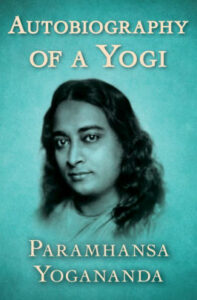Autobiography of a Yogi by Paramahansa Yogananda (printed by Jaico Books).
Autobiography of a Yogi – Review by Vishwanath Iyer. 
Paramahansa Yogananda (5 January 1893 – 7 March 1952) was born in Gorakhpur, Uttar Pradesh, India. After seeking various saints, he met his Guru, Swami Yukteswar Giri. Next, at the instruction of his Guru, he passed his Intermediate Examination in Arts from the Scottish Church College, Kolkata, in June 1915. Following this, he graduated with a degree similar to a current day Bachelor of Arts or B.A. (which at the time was referred to as an A.B.), from Serampore College. The same year, he took formal vows into the Swami order as Swami Yogananda Giri. In 1920, he moved to the United States of America, where he established his ashram and spent most of his life.
The Book:
The book is like any autobiography. Initially, it starts off with a wholesome childhood, spent with loving and caring parents in a deeply spiritual home. The central theme of the early chapters is the constant quest for a Guru, and greater understanding of the permanent. There are many miracles and personal experiences, including the traumatic demise of his mother. Next, the book touches upon his meeting of many masters such as Maharishi Mahasaya, a disciple of Sri Ramakrishna Paramahansa.
The meeting with his Guru Swami Yukteswar Giri is explained in vivid detail. Following this, are carefree and lyrical years at the Swami’s ashram and days as a college student. Slowly, Swami Yogananda begins to delve into his ascent into spiritual heights, explaining many nuances on the subject. Finally, this section ends in Swami Yogananda taking monastic vows.
Next, the book covers Kriya Yoga, founding a school at Ranchi and other achievements in social and spiritual life. Following this is a deep dive into the ethos of his Guru lineage and its development. Also, this section dwells on his travel abroad to speak and propagate Spirituality, ending with his establishment of his Ashram and Self Realisation Foundation in California, USA.
Conclusion:
The book is a fascinating read for two reasons. First, it shines a light on the spiritual base of India, as it existed at the turn of the century. Tragically, this base has been deeply eroded and exists in very few places. Secondly, the book is able to motivate one to delve into spirituality and Yoga. Despite its age, the principles of spirituality are still relevant and this book exemplifies this eternal message of the soul.
The book is crisp, with very little meandering. In fact, as a personal autobiography, it is an engaging, absorbing and delightful book to read.